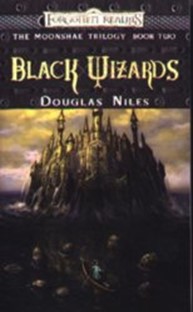 Douglas Niles’ second book in the Moonshae Trilogy, Black Wizards, was first published in April 1988, as the third release of the Forgotten Realms novel line. It continued the story of the Prince of Corwell, Tristran Kendrick, and his friends.
Douglas Niles’ second book in the Moonshae Trilogy, Black Wizards, was first published in April 1988, as the third release of the Forgotten Realms novel line. It continued the story of the Prince of Corwell, Tristran Kendrick, and his friends.
With the Darkwalker defeated, the relationship between Tristan and his father has returned to its natural state; that is, not a very good one. When assassins kill his father, it requires the young prince to grow up quickly and assume the throne. Unfortunately, the kingship won’t pass to him automatically, as there’s another lord contesting the throne. So, they must both travel to the High King in Caer Callidyr to get him to rule on who should assume the throne. However, with a cabal of evil wizards and a priest of the God of Assassins opposing them, this isn’t as simple as it first seems, and most of the book sees Tristan narrowly avoiding death while managing to gather a number of allies. Meanwhile, his rival manages to be mostly a faceless cipher who occasionally sneers at Tristan.
In the other plot strand, Robyn is training with the High Druid of the Moonshaes (who is also her aunt). This training is disrupted when agents of Bhaal start interfering, starting a chain of events that isn’t good for the druids, and eventually she rejoins Tristan and helps him in his quest.
Black Wizards doesn’t suffer from the same level of awful dialogue as Darkwalker on Moonshae, although the writing still isn’t fantastic. It does suffer horribly from underdeveloped characters and a first half that is often boring; the scenes with Robyn training being particularly dull, despite the attempt to inject humour into them through the use of the faerie dragon, Newt. There are amusing side-kicks that work (see Loiosh in Jhereg), but Newt reminds me entirely too much of the faeries in Willow – annoying and not adding enough to the plot to justify his inclusion.
The titular villains, the Black Wizards, are a mixed bag. They give us the first mention of the Red Wizards of Thay in a novel, as well as setting up Waterdeep as a hive of evil wizards. (Not really, but you can read it that way). They spend a lot of time plotting against each other and generally not appearing like they could ever work together. Far more effective is Hobarth, the priest of Bhaal, who causes so many troubles for the druids.
One of my biggest problems with the entire trilogy is the treatment of the Earthmother and the druids. I’ll go into it more in my review of the final book, but the druids generally come off as completely ineffective against Bhaal. It really makes me wonder how the Moonshaes have managed to go unconquered for so long.
The story picks up in the latter half of the book, aided by some excellent action sequences and plot developments, and the ending is pretty good.
Ultimately, the book suffers most from the characters being thinly drawn; there’s not really much depth to them. Daryth, the refugee from Calimsham, has the most interesting story, but we only get glimpses of it. The plot works, but takes a little too long to really get going. It’s occasionally an enjoyable book, but not a great one.
